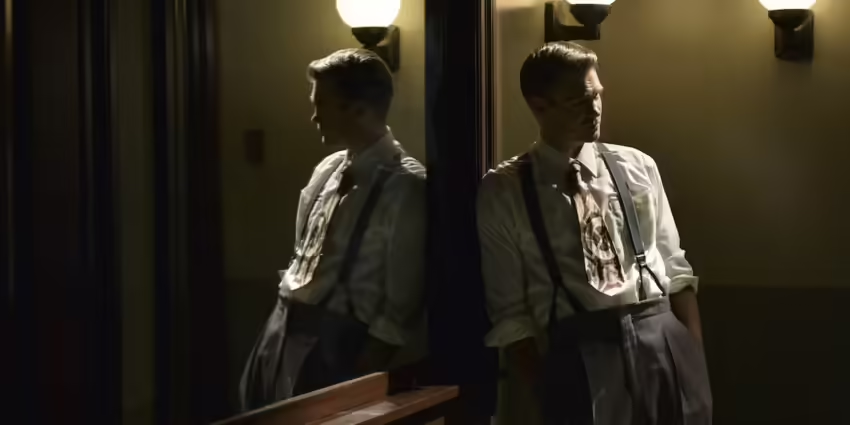Last week we looked at Agent Carter, and how that show absolutely nailed dealing with a character who faces discrimination. But that’s only one side of the coin. Necessarily, a character who faces discrimination must be discriminated against by someone, right?
And writing characters who discriminate can be hard. Too many writers fall into the trap of assuming that those who randomly discriminate must have no reason to discriminate in the first place. They must simply be bad people with no rationale behind their actions. So the readers end up watching the protagonist face a caricature, rather than a character who is just as well-fleshed out as those around him.
How do we write characters who discriminate? How can we dive into their psychology and understand their hatred without making an excuse for it? How can we hint at the character’s internal rationale without spelling it out to our readers?
Here to answer these questions is, once again, Agent Carter.
Agent Carter
It’s a year after the war, and Peggy Carter is still working at the Strategic Scientific Reserve (or SSR), even though many people believe both she and the organization have outlived their usefulness. The war is over, after all, and it’s time for her to head home. Her coworker, Jack Thompson, is the most vocal advocate of getting rid of Peggy. Her only possible worth within the SSR seems to be filing paperwork and taking lunch orders. No one will give her anything else to do, and he doesn’t understand why she stays.
So finally he asks her. Why does she stay, when she doesn’t get to “protect democracy” like she set out to do? Doesn’t she understand she doesn’t belong in the SSR? Why does she fight the order of the universe? She’s a woman, after all, and no man will ever truly see her as an equal.
“It’s sad,” he concludes, “but it doesn’t mean it’s any less true.”
Peggy knows his opinion of her, so the only reason she asks to join him on a mission to Russia is because she’ll finally get the chance to stretch her legs and do some honest field work — something she’s been missing since the war. On mission, they are joined by the Howling Commandos, Captain America’s regiment. For once, Thompson is the one out of the loop. The Commandos reunite with Peggy as though she’s family, and Thompson, who’s supposed to be leading the mission, ends up out of his depth. Throughout the mission, Peggy and the Commandos reminisce on old times, sharing their favorite war stories and memories from the battlefield. Peggy’s finally back in a place where she feels as though she belongs.
Finally, the Commandos ask if Thompson has a war story, and he reluctantly opens up. He shares a time when he was on duty in Japan, guarding his sleeping camp of allied soldiers. Exhausted like the rest of his unit, he dozed off in the middle of his shift. He awoke to find a group of Japanese soldiers had infiltrated the unprepared and virtually defenseless camp. Miraculously, he was able to stop the soldiers just seconds before it was too late, saving his entire unit and earning a Navy Cross medal for his actions.
There’s silence around the camp as the Commandos suddenly see Thompson’s worth. In just one conversation he’s earned their respect and honor for his bravery. And so while Thompson begins to see Peggy’s skill and value on the battlefield while she fearlessly leads the Howling Commandos to victory, Peggy begins to see Jack’s value — his humility when he accepts her plan over his own, and his bravery and honor when leading a regiment of men into danger.
But as Peggy and Jack are on their way back to the States, Peggy notices something’s troubling him, which is strange considering that the mission went well. He’ll go back to the SSR a hero, while Peggy will have to deal with the prejudice that’s become her norm. She asks Jack what’s bothering him, and Jack finally admits that he didn’t tell the full story of what earned him his Navy Cross. The men he killed that day carried a white flag, seeking surrender. And he shot them before he could see it.
When he found out, the guilt absolutely killed him.
So he buried the flag and his conscience and hoped no one ever found out.
“And every day,” he whispers, “It gets harder and harder to live with.”
Explain, Don’t Excuse
This scene matters so much because it shows the intentionality with which the writers created their characters. We understand why Jack has so much beef with Peggy, with her only ally Daniel Sousa, and his boss, Chief Dooley, for allowing her to stay. Because he’s condemned by his own conscience and constantly tortured by the fact that he’s assumed an identity that is false. His conscience says he’s a coward and a liar, no matter how hard he tries to ignore it. Every day, it becomes harder for him to keep it together because the cognitive dissonance is killing him.
The only way he can reconcile it is by viewing everyone else as broken as he is. If he can make everyone around him out to be just as contemptible, just as immoral as he is, then what he did isn’t really so bad. If he can just convince himself that Peggy is fighting the universe instead of trying to save democracy, maybe he can live with himself. If she’s lying to herself, day in and day out, to convince herself that what she’s doing is right when in her heart she knows the SSR is no place for her, then she’s really no better than he is. If Daniel Sousa is protecting her not because she’s being unjustly targeted, but because he wants to appear morally superior, then he wants the same thing as Jack — to prove to the world that he is right by lying to himself that those around him are wrong. If Chief Dooley is a coward for allowing a woman to boss him around, if he has no spine because he would allow Peggy to stay far past her use as an agent, then Dooley’s a coward, like Jack is.
And suddenly each one of Jack’s actions fall into place. Each of them exist for a reason.
Too many of the sexist, racist, or bigoted villains in today’s stories are just that. Their entire identity is wrapped up in who they choose to single out and harm, and they do it for no reason. But everyone does something for a reason, even something as needless as targeting those who are different.
And it’s worth noting that this interaction didn’t make Jack Thompson’s actions right. It didn’t excuse the horrible way he treats Peggy and Sousa or even the way that he scoffs at Chief Dooley. The writers understood you can explain actions without excusing him, and that’s exactly what they did here. Every mean comment, every snub, everything Jack Thompson has done now makes sense — even if it still isn’t right.
Too many writers are afraid that if they offer a rationale for a character’s prejudice, they’ll come across as excusing it. But that simply isn’t the case. Every villain, no matter the crime, has a reason for doing what they do. Showing those reasons doesn’t excuse their actions. Instead, it shows your readers that your antagonist isn’t there just because you wanted to tell a story about discrimination. It shows that your characters — both good and bad — are motivated to act the way that they do. Their actions are not random, they’re intentional. They’re set up for a particular purpose — demonstrating your theme.
But what if you don’t have a moment for your character to open up? What if he or she becomes only more corrupted as the story goes on? What if the readers never get a window into what drives their hatred?
You don’t always have to show your readers what’s going on in each of your character’s heads. But you do have to figure it out as the writer. A character who hurts others for no reason will stick out like a sore thumb, even if your readers can’t put their finger on why. But a character who is hurting and hurts others will slip seamlessly into your cast. Your readers might not necessarily figure out why your character acts the way he does, but the way that they speak, the way that they act, and the choices that they make will reveal that there is intention and motivation behind them. They aren’t just a plot device. They have depth and meaning.
You don’t have to offer an excuse for your character’s actions. You don’t have to make it seem like your discriminating character is just the misunderstood victim of his own story. But you should understand what’s driving him to hurt those around him and what he hopes to gain by discriminating against others for no apparent reason.
If you do, you will have a fully fleshed-out antagonist with depth and meaning behind his actions. You will have created a character with more nuance than many of the discriminating characters in literature today. And whether or not you plan to redeem him, he will stand out as a remarkably well-thought out character — and one that makes your theme crystal-clear.



Let us know in the comments:
What stories have you read that tackle discrimination? How did they write their antagonist? What antagonists have surprised you with their depth?


Hi! My name is Mara, and I’m a Christian artist, violinist, and blogger. I remember the day that I decided that I would learn something new about what makes a good story from every book I picked up — whether it was good, bad, or a mixture of both. I use this blog as a way of sharing some of the tips and tricks I’ve learned, and highlight which books, cartoons, and movies have taught me the most about writing an awesome story.


Wow! This is amazing! All your articles on villains, especially this one, have taught me that there can be so much more to them than the Sauron stereotype. Fantastic work!!
Thanks! I’m so glad this has been helpful!